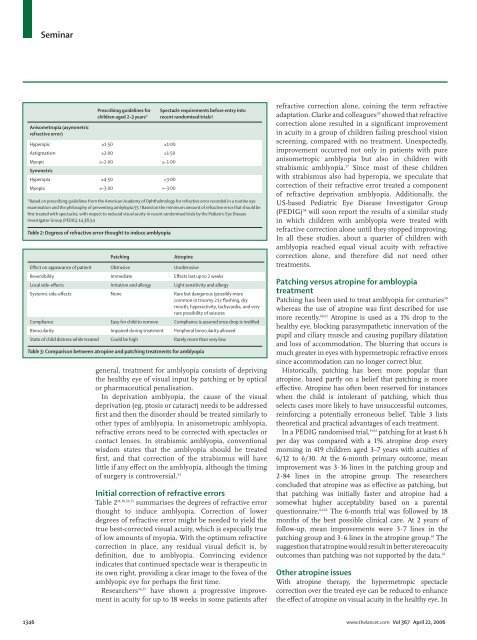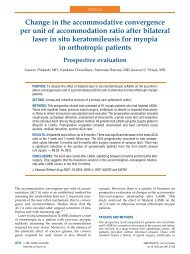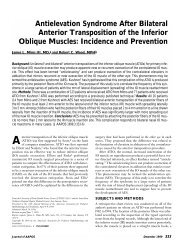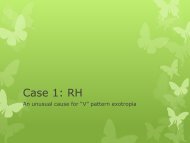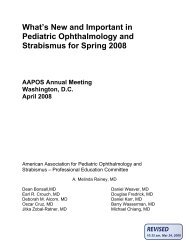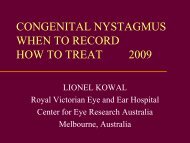Epidemiology of amblyopia - The Private Eye Clinic
Epidemiology of amblyopia - The Private Eye Clinic
Epidemiology of amblyopia - The Private Eye Clinic
Create successful ePaper yourself
Turn your PDF publications into a flip-book with our unique Google optimized e-Paper software.
Seminar<br />
Prescribing guidelines for<br />
children aged 2–3 years*<br />
Anisometropia (asymmetric<br />
refractive error)<br />
Hyperopic ≥1·50 ≥1·00<br />
Astigmatism ≥2·00 ≥1·50<br />
Myopic ≥–2·00 ≥–1·00<br />
Symmetric<br />
Hyperopia ≥4·50 >3·00<br />
Myopia ≥–3·00 >–3·00<br />
Spectacle requirements before entry into<br />
recent randomised trials†<br />
*Based on prescribing guidelines from the American Academy <strong>of</strong> Ophthalmology for refractive error recorded in a routine eye<br />
examination and the philosophy <strong>of</strong> preventing ambylopia.55 †Based on the minimum amount <strong>of</strong> refractive error that should be<br />
first treated with spectacles, with respect to reduced visual acuity in recent randomised trials by the Pediatric <strong>Eye</strong> Disease<br />
Investigator Group (PEDIG).14,38,54<br />
Table 2: Degrees <strong>of</strong> refractive error thought to induce <strong>amblyopia</strong><br />
Patching<br />
Atropine<br />
Effect on appearance <strong>of</strong> patient Obtrusive Unobtrusive<br />
Reversibility Immediate Effects last up to 2 weeks<br />
Local side-effects Irritation and allergy Light sensitivity and allergy<br />
Systemic side-effects None Rare but dangerous (possibly more<br />
common in trisomy 21): flushing, dry<br />
mouth, hyperactivity, tachycardia, and very<br />
rare possibility <strong>of</strong> seizures<br />
Compliance Easy for child to remove Compliance is assured once drop is instilled<br />
Binocularity Impaired during treatment Peripheral binocularity allowed<br />
State <strong>of</strong> child distress while treated Could be high Rarely more than very low<br />
Table 3: Comparison between atropine and patching treatments for <strong>amblyopia</strong><br />
general, treatment for <strong>amblyopia</strong> consists <strong>of</strong> depriving<br />
the healthy eye <strong>of</strong> visual input by patching or by optical<br />
or pharmaceutical penalisation.<br />
In deprivation <strong>amblyopia</strong>, the cause <strong>of</strong> the visual<br />
deprivation (eg, ptosis or cataract) needs to be addressed<br />
first and then the disorder should be treated similarly to<br />
other types <strong>of</strong> <strong>amblyopia</strong>. In anisometropic <strong>amblyopia</strong>,<br />
refractive errors need to be corrected with spectacles or<br />
contact lenses. In strabismic <strong>amblyopia</strong>, conventional<br />
wisdom states that the <strong>amblyopia</strong> should be treated<br />
first, and that correction <strong>of</strong> the strabismus will have<br />
little if any effect on the <strong>amblyopia</strong>, although the timing<br />
<strong>of</strong> surgery is controversial. 53<br />
Initial correction <strong>of</strong> refractive errors<br />
Table 2 14,38,54,55 summarises the degrees <strong>of</strong> refractive error<br />
thought to induce <strong>amblyopia</strong>. Correction <strong>of</strong> lower<br />
degrees <strong>of</strong> refractive error might be needed to yield the<br />
true best-corrected visual acuity, which is especially true<br />
<strong>of</strong> low amounts <strong>of</strong> myopia. With the optimum refractive<br />
correction in place, any residual visual deficit is, by<br />
definition, due to <strong>amblyopia</strong>. Convincing evidence<br />
indicates that continued spectacle wear is therapeutic in<br />
its own right, providing a clear image to the fovea <strong>of</strong> the<br />
amblyopic eye for perhaps the first time.<br />
Researchers 56,57 have shown a progressive improvement<br />
in acuity for up to 18 weeks in some patients after<br />
refractive correction alone, coining the term refractive<br />
adaptation. Clarke and colleagues 39 showed that refractive<br />
correction alone resulted in a significant improvement<br />
in acuity in a group <strong>of</strong> children failing preschool vision<br />
screening, compared with no treatment. Unexpectedly,<br />
improvement occurred not only in patients with pure<br />
anisometropic <strong>amblyopia</strong> but also in children with<br />
strabismic <strong>amblyopia</strong>. 57 Since most <strong>of</strong> these children<br />
with strabismus also had hyperopia, we speculate that<br />
correction <strong>of</strong> their refractive error treated a component<br />
<strong>of</strong> refractive deprivation <strong>amblyopia</strong>. Additionally, the<br />
US-based Pediatric <strong>Eye</strong> Disease Investigator Group<br />
(PEDIG) 58 will soon report the results <strong>of</strong> a similar study<br />
in which children with <strong>amblyopia</strong> were treated with<br />
refractive correction alone until they stopped improving.<br />
In all these studies, about a quarter <strong>of</strong> children with<br />
<strong>amblyopia</strong> reached equal visual acuity with refractive<br />
correction alone, and therefore did not need other<br />
treatments.<br />
Patching versus atropine for ambloypia<br />
treatment<br />
Patching has been used to treat <strong>amblyopia</strong> for centuries 59<br />
whereas the use <strong>of</strong> atropine was first described for use<br />
more recently. 60,61 Atropine is used as a 1% drop to the<br />
healthy eye, blocking parasympathetic innervation <strong>of</strong> the<br />
pupil and ciliary muscle and causing pupillary dilatation<br />
and loss <strong>of</strong> accommodation. <strong>The</strong> blurring that occurs is<br />
much greater in eyes with hypermetropic refractive errors<br />
since accommodation can no longer correct blur.<br />
Historically, patching has been more popular than<br />
atropine, based partly on a belief that patching is more<br />
effective. Atropine has <strong>of</strong>ten been reserved for instances<br />
when the child is intolerant <strong>of</strong> patching, which thus<br />
selects cases more likely to have unsuccessful outcomes,<br />
reinforcing a potentially erroneous belief. Table 3 lists<br />
theoretical and practical advantages <strong>of</strong> each treatment.<br />
In a PEDIG randomised trial, 14,61 patching for at least 6 h<br />
per day was compared with a 1% atropine drop every<br />
morning in 419 children aged 3–7 years with acuities <strong>of</strong><br />
6/12 to 6/30. At the 6-month primary outcome, mean<br />
improvement was 3·16 lines in the patching group and<br />
2·84 lines in the atropine group. <strong>The</strong> researchers<br />
concluded that atropine was as effective as patching, but<br />
that patching was initially faster and atropine had a<br />
somewhat higher acceptability based on a parental<br />
questionnaire. 62,63 <strong>The</strong> 6-month trial was followed by 18<br />
months <strong>of</strong> the best possible clinical care. At 2 years <strong>of</strong><br />
follow-up, mean improvements were 3·7 lines in the<br />
patching group and 3·6 lines in the atropine group. 61 <strong>The</strong><br />
suggestion that atropine would result in better stereoacuity<br />
outcomes than patching was not supported by the data. 61<br />
Other atropine issues<br />
With atropine therapy, the hypermetropic spectacle<br />
correction over the treated eye can be reduced to enhance<br />
the effect <strong>of</strong> atropine on visual acuity in the healthy eye. In<br />
1346 www.thelancet.com Vol 367 April 22, 2006


